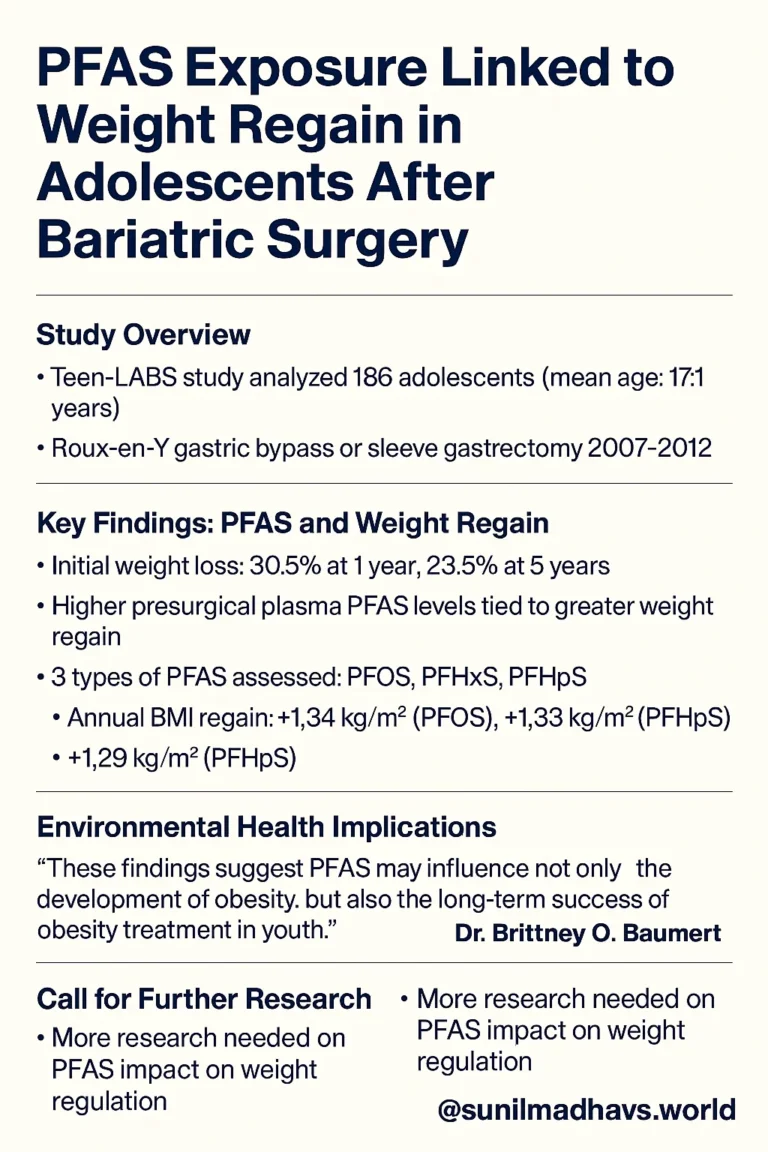–Key Insights:
– Adolescents with higher presurgical blood levels of three types of per- and polyfluoroalkyl substances (PFAS) were more likely to experience weight regain after bariatric surgery.
– Researchers recommend further studies to understand how PFAS may affect outcomes of other obesity treatments.
A recent study published in *Obesity* suggests that teenagers undergoing bariatric surgery tend to regain more weight if they have elevated levels of PFAS in their bloodstream before surgery. These findings come from the Teen-LABS study, which tracks the long-term effects of bariatric surgery in patients 19 years and younger.
The analysis revealed that adolescents with higher plasma concentrations of three perfluoroalkyl sulfonic acids showed greater increases in BMI, body weight, and waist circumference between 1 and 5 years post-surgery.

### Study Details
– Participants: 186 adolescents (average age 17.1 years; 76.3% female) who underwent Roux-en-Y gastric bypass or sleeve gastrectomy between 2007 and 2012.
– Measurements: PFAS levels were determined using fasting blood samples collected 30 days before surgery. BMI, weight, and waist circumference were recorded at 6 months, 1 year, 3 years, and 5 years after surgery.
Initial Weight Loss: On average, participants lost 30.5% of their body weight within the first year. By the fifth year, the average weight loss was 23.5% compared with baseline.
—
### PFAS Exposure and Weight Regain
– PFOS (perfluorooctane sulfonate): Adolescents exposed to 2.73 ng/mL regained 1.34 kg/m² BMI per year.
– PFHxS (perfluorohexane sulfonic acid): At 0.9 ng/mL, adolescents showed a 1.33 kg/m² BMI regain annually.
– PFHpS (perfluoroheptanesulfonic acid): At 0.1 ng/mL, BMI increased by 1.29 kg/m² per year.
The statistical analyses confirmed significant interactions between PFAS levels and BMI change for all three chemicals.
**Body weight regain:**
– Exposure to PFOS (2.73 ng/mL) was tied to a 2.73 percentage point increase in body weight annually.
– PFHpS exposure (0.1 ng/mL) led to a 2.59 percentage point rise annually.
– Those in the highest tertile for PFHpS exposure regained 4.31 percentage points per year, compared with 2.68 points for those in the lowest tertile.
**Waist circumference:**
– A PFHxS level of 0.9 ng/mL corresponded to an annual 0.29 cm increase in waist size.
– Adolescents in the highest tertile for PFHpS exposure experienced an annual 2.74 cm waist increase, compared with just 0.29 cm in the lowest tertile.
**Combined PFAS effects:** When PFOS, PFHxS, and PFHpS were evaluated together as a mixture, every one-quartile increase corresponded to a 4.41 cm increase in waist circumference at 5 years. Interestingly, this combined effect was not significantly tied to BMI or total weight regain after 5 years.
—
### Implications and Research Gaps
Lead author Brittney O. Baumert, PhD, MPH (Keck School of Medicine, USC) explained that the findings provide new insight into how environmental exposures may impact not just obesity development, but also the long-term success of surgical weight-loss treatments.
She emphasized the need to incorporate environmental health considerations into obesity treatment strategies, suggesting that doing so could improve outcomes over time.
Baumert also pointed out steps individuals can take to lower PFAS exposure, such as:
– Replacing nonstick cookware with PFAS-free alternatives,
– Using water filters capable of removing PFAS,
– Checking labels to avoid PFAS-containing products.
**Future Directions:** Researchers should explore whether PFAS affects weight outcomes in people using obesity medications and investigate the biological mechanisms linking PFAS exposure to weight regulation. Baumert also suggested integrating environmental biomarker screening into long-term obesity intervention trials to help tailor follow-up care and provide better counseling for patients.
—
**Contact:** Brittney O. Baumert, PhD, MPH – bbaumert@usc.edu | Instagram: @brittneybaumertphd | LinkedIn: @BrittneyOliviaBaumert
**Disclosures:** Baumert reported no financial conflicts of interest. Full disclosure information for other study authors is available in the published paper.

